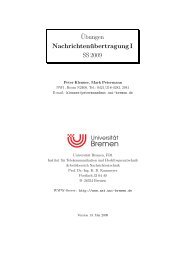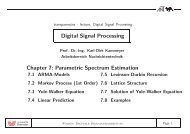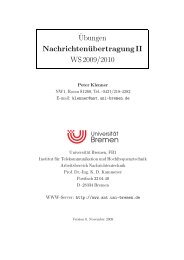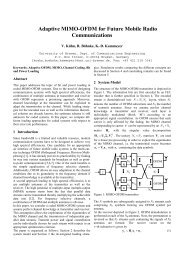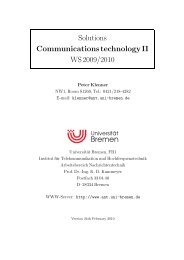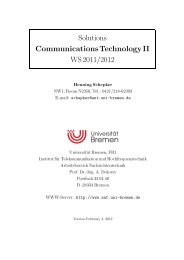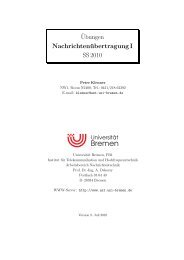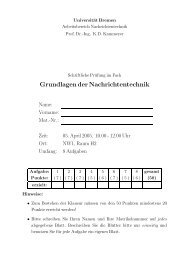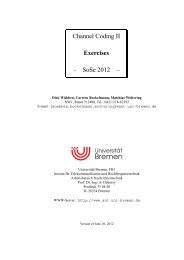Iterative Blind Channel Estimation for OFDM Receivers
Iterative Blind Channel Estimation for OFDM Receivers
Iterative Blind Channel Estimation for OFDM Receivers
Create successful ePaper yourself
Turn your PDF publications into a flip-book with our unique Google optimized e-Paper software.
THIRD INTERNATIONAL WORKSHOP ON MC-SS & RELATED TOPICS, OBERPFAFFENHOFEN, GERMANY, 26-28 SEPTEMBER 2001 1<br />
<strong>Iterative</strong> <strong>Blind</strong> <strong>Channel</strong> <strong>Estimation</strong> <strong>for</strong> <strong>OFDM</strong> <strong>Receivers</strong><br />
Karl-Dirk Kammeyer, Thorsten Petermann, and Sven Vogeler<br />
University of Bremen, Department of Communications Engineering<br />
P.O. Box 33 04 40, D-28334 Bremen, Germany<br />
E-mail: ¡ kammeyer, petermann, vogeler¢ @comm.uni-bremen.de<br />
Abstract<br />
Finite-Alphabet based blind channel estimation in<br />
<strong>OFDM</strong> systems is known to be extremely complex due to<br />
an exhaustive search to be per<strong>for</strong>med over a tremendous<br />
number of channel coefficient combinations. In this paper,<br />
we present a novel blind channel estimator, which dramatically<br />
reduces this number of coefficient combinations to<br />
be checked without a significant deterioration in estimation<br />
quality. Hence, the new low complexity approach enables<br />
the application of blind channel estimators based on the finite<br />
alphabet set even if the transmitted data are high-rate<br />
modulated. Furthermore, we show that the per<strong>for</strong>mance of<br />
blind channel estimation can be improved by an iterative<br />
process based upon the capabilities of channel coding. Using<br />
bit error rates (BERs) be<strong>for</strong>e and after channel decoding,<br />
the algorithm is tested with simulations and compared<br />
to other blind and non-blind channel estimators.<br />
1 Introduction<br />
In recent years, Orthogonal Frequency Division Multiplexing<br />
(<strong>OFDM</strong>) has become one of the most important<br />
techniques <strong>for</strong> high-rate wireless data transmission. Especially,<br />
it has been proposed <strong>for</strong> the European HIPER-<br />
LAN/2 standard and the American equivalent IEEE802.11a,<br />
which are two similar concepts <strong>for</strong> broadband wireless local<br />
area networks (WLAN) in £¥¤§¦©¨ the band. Furthermore,<br />
<strong>OFDM</strong> is currently being adopted and tested to digital audio<br />
and video broadcasting (DAB/DVB) and high speed asynchronous<br />
digital subscriber line (A-DSL) modems.<br />
Since most of the mentioned standards include coherent<br />
data demodulation, the transmission channel has to be<br />
estimated. Generally, this is achieved by non-blind channel<br />
estimators exploiting additionally transmitted training<br />
data. Moreover, the training sequences have to be transmitted<br />
periodically, since the channel in wireless applications<br />
This research was supported by the German NSF (DFG contr. #Ka<br />
<br />
841/5-1).<br />
normally is time variant. In order to increase bandwidth<br />
efficiency, blind channel estimation, on the other hand, is<br />
well motivated since it avoids the need of any training data.<br />
In recent publications, several blind channel estimation approaches<br />
based on cyclostationarity [2, 3] or subspace decompositions<br />
[4] have been tested <strong>for</strong> <strong>OFDM</strong> systems. Both<br />
classes of estimators are known to require long enough<br />
data records, in order to derive unbiased channel estimates.<br />
While subspace methods in general suffer from fading subcarriers<br />
(i.e. the channel has nulls on some subcarriers),<br />
the main drawback of algorithms based on cyclostationary<br />
statistics is their sensibility towards “singular” channel<br />
classes with common subsystems (i.e. common zeros)<br />
in all polyphase subchannels. Furthermore, cyclostationary<br />
methods require some excess bandwidth. In [6], a novel<br />
blind channel estimator has been presented which is based<br />
on the knowledge that the modulated and transmitted data<br />
are confined to a finite alphabet set. This so-called Minimum<br />
Distance (MD) algorithm copes with all the problems<br />
mentioned be<strong>for</strong>e. In this paper, we present the new Minimum<br />
Impulse Length (MIL) approach, which shows a better<br />
estimation per<strong>for</strong>mance than MD. However, both MIL<br />
and MD require an enormous computional ef<strong>for</strong>t. In contrast,<br />
our Clustered SubCarriers (CSC) scheme dramatically<br />
reduces this ef<strong>for</strong>t without any significant deterioration in<br />
estimation quality. Furthermore, estimation quality can be<br />
improved by an iterative channel estimation scheme even if<br />
the channel is highly time variant.<br />
The paper is organized as follows: Section 2 gives an<br />
overview of the <strong>OFDM</strong> system. In section 3, the principles<br />
of non-blind and blind channel estimation are described.<br />
Exploiting the capabilities of channel coding, we present in<br />
section 4 the Turbo <strong>Channel</strong> <strong>Estimation</strong> <strong>for</strong> an initial nonblind<br />
or blind estimator. After showing some simulation<br />
results in section 5, the paper is concluded in section 6.<br />
2 Data Transmission in <strong>OFDM</strong> systems<br />
Figure 1 shows the conventional <strong>OFDM</strong> system with<br />
Cyclic Prefix (CP). The CP of length larger than the
`cbe "!gf,hjiQkl# mn/o & [(pmn/oJq;r<br />
P<br />
where<br />
P<br />
w<br />
_<br />
N<br />
THIRD INTERNATIONAL WORKSHOP ON MC-SS & RELATED TOPICS, OBERPFAFFENHOFEN, GERMANY, 26-28 SEPTEMBER 2001 2<br />
channel order avoids the received data from being disturbed<br />
by inter-symbol (ISI) or inter-carrier interference<br />
(ICI). In the transmitter, the channel encoded in<strong>for</strong>mation<br />
`Ž˜! f,h9ik\# nK&'[(*n+[(0././.0(*n¡243‰+¡¢7 where with equalizer<br />
n¡w‰£!¤¡¥§… mƒ‡w coefficients . Finally, each <strong>OFDM</strong> symbol<br />
is ( 3‰+<br />
de-interleaved ), P/S converted, and channel de-<br />
;§9 . If channel decoding is based on soft<br />
¦<br />
coded into bits …<br />
<strong>OFDM</strong> Transmitter<br />
u(<br />
k´)<br />
Chan. b( k)<br />
S/P<br />
encod.<br />
<strong>OFDM</strong> Receiver<br />
^<br />
u( k´)<br />
Chan.<br />
decod.<br />
^<br />
b k<br />
( )<br />
P/S<br />
f<br />
f<br />
-1<br />
Mod.<br />
Mod.<br />
Mod.<br />
d n,ref<br />
d n,ref<br />
e ( i)<br />
^<br />
d0( i)<br />
Dem..<br />
^<br />
d1( i)<br />
Dem.<br />
^<br />
n<br />
dN-1( i)<br />
Dem.<br />
b.a.<br />
b.a.<br />
d0( i)<br />
d1( i)<br />
dN-1( i)<br />
b.a.<br />
Chan.<br />
est.<br />
b.d.<br />
b.d.<br />
b.d.<br />
IFFT<br />
&<br />
Cyclic<br />
Prefix<br />
d<br />
~<br />
n,ref<br />
( i)<br />
disc.<br />
Prefix<br />
&<br />
FFT<br />
s0( i)<br />
s1( i)<br />
sP-1( i)<br />
P/S<br />
<strong>Channel</strong><br />
c( k)<br />
n( k)<br />
y0( i)<br />
y1( i)<br />
S/P<br />
yP-1( i)<br />
Figure 1: Conventional <strong>OFDM</strong> system with Cyclic Prefix<br />
s( k)<br />
y( k)<br />
stream is serial-to-parallel converted (S/P), interleaved<br />
), modulated, and assembled into so-called <strong>OFDM</strong> symbols<br />
of length .<br />
(<br />
"!$# %'&')(*%,+-)(/.0././(1%'2435+6-798<br />
; is :<br />
After P/S conversion, the <strong>OFDM</strong> sequence 1<br />
transmitted over the time discrete 4@<br />
channel<br />
@5A */BC/D EFHG 8<br />
, where @ denotes convolution, I is the chip<br />
ä<br />
¸ ·<br />
# % w TU¹´)µº7‰!<br />
+ µF<br />
<br />
¾<br />
ä<br />
where ê¥2 denotes the Öðc<br />
ñ<br />
<br />
é !¿iû1kMüh×ý þ …<br />
<br />
O P 2<br />
¨<br />
ú<br />
THIRD INTERNATIONAL WORKSHOP ON MC-SS & RELATED TOPICS, OBERPFAFFENHOFEN, GERMANY, 26-28 SEPTEMBER 2001 3<br />
3.2 <strong>Blind</strong> <strong>Channel</strong> <strong>Estimation</strong><br />
FFT matrix<br />
In [6], Zhou and Giannakis have presented the so-called<br />
Minimum Distance (MD) algorithm and its complexity reduced<br />
version MMD (Modified Minimum Distance). Both<br />
MD and MMD are based on the knowledge that ³ the -ary<br />
modulated signals 2 are drawn from a finite alphabet set of<br />
³ size , % w -‰}V«6´[µ¬¡· µ˜F + i.e. . From this it is easy to see<br />
that<br />
ê 2 !<br />
ó<br />
óò<br />
óôS0S/S<br />
3 o*¨1õ ç¢2 S0S/S†n 3 o*¨1õ t 2435+uç¢2<br />
n<br />
.<br />
.<br />
. .. .<br />
(9)<br />
and ë is the matrix’ Hermitian transpose, the correct channel<br />
estimate<br />
^n 3 o*¨*õ t 2º35+uç¢2 S0S/Sön 3 o*¨1õ t 243‰+Cu q ç¢2<br />
ø<br />
÷ùø<br />
ø<br />
» + (/./.0.)(*» ·<br />
where are determined by the constellation<br />
«¡´ µ ¬6· µ˜F + points . %'wH4¾ !¿ With , À let denote the smallest<br />
index <strong>for</strong> »ÂÁþ ! Ä*» µ ! (-ÅÇÆȱ¿À which . The calculation<br />
of (7) shows ÀÉ! ³ that ³ <strong>for</strong> -ary PSK ÀÉ! Ê and ³ <strong>for</strong> -<br />
ary QAM ³Ë!Ì0Í with Î , ÍÊ ,<br />
Ï<br />
, , and £Í . Concerning<br />
<br />
w -5X”» + %‡· 3‰+<br />
w %J·<br />
HXaS0S/SKX”» ·½¼ ! ( (7)<br />
the algorithms’ complexity, the fact À$±|³ that (and <strong>for</strong><br />
large signal À¹Ðѳ constellations ) plays a very important<br />
role.<br />
In [7], it was proven that <strong>for</strong> any signal constellation<br />
% Á ÒÃÓ<br />
-0Ôa!gU£-Àl¥)³ÕC» Á !Ö , where Ò «QS׬ denotes expectation<br />
value. With ˆ % Á<br />
w<br />
w 0ÙÚ!Ûm Á ƒJwl<br />
Ò Ó<br />
% Á<br />
w Ô and<br />
ÒWØ<br />
the replacement of % Á<br />
w /Ô by consistent sample averages<br />
(over ÒÜÓ <strong>OFDM</strong> symbols), m Á ƒ w is estimated as:<br />
Ý<br />
Oâ<br />
% Á<br />
w -ã (>Y}~# x(*€U‚)7 (8)<br />
ˆ<br />
corresponds to the impulse response with minimum mean<br />
power of the … §XÛ coefficients . An additional<br />
]
<br />
<br />
ä<br />
<br />
<br />
ä<br />
3<br />
…<br />
æ<br />
(<br />
P<br />
P<br />
(<br />
(<br />
<br />
…<br />
P<br />
…<br />
(<br />
ñ<br />
-<br />
ä<br />
.<br />
.<br />
P<br />
(<br />
ÿþ<br />
q<br />
P<br />
(<br />
(<br />
P<br />
<br />
ä<br />
(<br />
ñ<br />
P<br />
<br />
3<br />
(<br />
<br />
(<br />
ä<br />
P<br />
<br />
P<br />
<br />
é<br />
!<br />
THIRD INTERNATIONAL WORKSHOP ON MC-SS & RELATED TOPICS, OBERPFAFFENHOFEN, GERMANY, 26-28 SEPTEMBER 2001 4<br />
subplot depicts a steady phase course, except from the fading<br />
Y } «KÍx( (*ÎQx(*Îx¬ subcarriers , where phase discontinuities<br />
are obvious (dotted circles). Hence, it must be possible<br />
to track the scalar æ\w ambiguity of adjacent channel coefficients<br />
by choosing their minimum phase distances. This<br />
assumption is true as long as no phase discontinuities appear.<br />
Figure 3 shows the mƒ w fading channel coefficients ,<br />
, (a) and Y !ÌÎQ , Îx (b), and some of their neigh-<br />
Í Y=!<br />
bours according to Fig. 2 in the v complex -plane (black circles).<br />
If we compare, <strong>for</strong> instance, the relation between<br />
Imag <br />
a) C( n), n [4,9]<br />
1<br />
4<br />
9<br />
0.5 8 5<br />
7<br />
6<br />
0<br />
7’<br />
-0.5<br />
b) C( ), n [29,33]<br />
-1<br />
-1 -0.5 0 0.5 1 -1 -0.5 0 0.5 1<br />
Real <br />
Real <br />
Figure 3: Phase course of fading channel coefficients<br />
n<br />
33<br />
32<br />
31<br />
and mƒK on the one hand and mƒ¡ and mƒ¡<br />
mƒ0<br />
on the other, it is clear that the closer the coefficients are to<br />
the origin, the larger their phase differences can be, even if<br />
the Euclidean distance remains constant. Under assumption<br />
of BPSK modulated signals and starting mƒ from , the<br />
choice of the minimum phase difference would lead to the<br />
wrong mƒ coefficient (empty circle) instead mƒ of .<br />
Since this error influences all further decisions, a correct<br />
estimation mƒ,w of will be impossible. Fig. 3b indicates<br />
the same behaviour <strong>for</strong> ±ßY ±ßÎx . There<strong>for</strong>e, we separated<br />
the transfer function into different clusters consisting<br />
of adjacent strong channel coefficients, whose magnitudes<br />
<br />
are above a certain 0E ª threshold (see Fig. 2). Within these<br />
clusters, phase discontinuities are very unlikely. Let denote<br />
the number of clusters, which is, in general, smaller<br />
£ than . With this, we have dramatically reduced the number<br />
of combinations À 2<br />
from (MD) À 2 §©<br />
and (MMD) to<br />
Ê . Moreover, CSC can exploit more sub-<br />
Ê ! K À̱<br />
carriers, since MMD only chooses XÕ or elements<br />
with largest absolute values. 3<br />
We will now give an overview of the CSC algorithm according<br />
to the MD/MMD scheme presented in [6]:<br />
30<br />
31’<br />
29<br />
@ Á where is À the -fold convolution < of with itself<br />
N Á ¢ +£ z! Éê¥2«' j(/£ ‡JÀ†X Q¬ and defines eð an<br />
trans<strong>for</strong>m matrix created from the first JÀ–X<br />
JÀ–X¿<br />
columns 4 ê¥2 of<br />
pseudo-inverse.<br />
(9). In (11), denotes the matrix’<br />
2. …<br />
ä<br />
+ Calculate and separate it into clusters of<br />
')(<br />
length<br />
*}~# x(+cU–)7 , , where all coefficients that fall below<br />
the /E ª threshold are omitted due to their phase discontinuity<br />
property. The predefinition of the threshold<br />
is very important, since clusters might contain phase<br />
discontinuities or consist of too little channel coefficients<br />
E ª if was set too high or too low, respectively.<br />
3. By exploiting the correlation between adjacent channel<br />
coefficients, search their minimum phase distances<br />
within each * cluster and track the scalar ambiguity<br />
factors<br />
where<br />
ƒ m˜<br />
… m ƒ #<br />
,”! iû1köüh×ý . … m ƒ © ,J3‰+/ÂU¹æ #'… m Á ƒ © ,¢7 +CçpÁ<br />
©<br />
} #×Q(<br />
' (<br />
U )7¢(>æ © &4!Õ'( (12)<br />
/<br />
ƒ © , á! æ © , #J… m Á ƒ © , ¢7 +*ç1Á<br />
. Collect<br />
m˜<br />
, in an '!( ðÈ cluster vector … ©<br />
(<br />
©<br />
4. Since now every cluster vector …<br />
&¡[(/.0./.0( … m ©<br />
ƒ<br />
© 021Q3‰+)-7 8 .<br />
(<br />
©<br />
scalar ambiguity (instead of ), the remaining ambiguities<br />
can be resolved by searching over ' ( Ð À 2 À<br />
.<br />
.<br />
( .<br />
contains only one<br />
possible … ¨ !„# æ & …<br />
ä<br />
© & (/.0./.)(pæ 35+ …<br />
ä<br />
© 3‰+ 7 8 vectors .<br />
5. Based on the total number of clustered subcarriers<br />
3<br />
The notation 5:<br />
, calculate the time domain vectors … ¨ !<br />
<br />
N£¢ +54 A76 B98‡n6 with 3 N£¢ + "! Éê 2 «';:<br />
2 (0V ²'¬ .<br />
<br />
indicates that 3 N£¢ + only contains the<br />
2<br />
rows ê¥2 of belonging to the 3 selected<br />
Furthermore, the selection of only columns ê©2 of<br />
corresponds to the noise reduction according to (6).<br />
6. With …<br />
<br />
subcarriers.<br />
of (11) channel estimates are finally found by<br />
Á<br />
minimizing the Euclidean Distance<br />
é !¿iQû*köühjý<br />
D×D …<br />
<br />
Á U …<br />
é<br />
¨ @ Á …<br />
é<br />
and …<br />
é<br />
trans<strong>for</strong>ming into frequency domain.<br />
¨ D×D (13)<br />
1. … m Á ƒ‡w Collect from (8) in Ñð‚ an … Á¿ z!<br />
vektor<br />
m Á ƒJ&¡)(/./.0./(Œ… m Á ƒ‡243‰+)-7 8 and calculate the corresponding<br />
reference …<br />
#'…<br />
N Á‡7 8 !<br />
vector<br />
by IFFT into time domain<br />
k<br />
¨<br />
'<br />
<br />
…<br />
ˆ<br />
THIRD INTERNATIONAL WORKSHOP ON MC-SS & RELATED TOPICS, OBERPFAFFENHOFEN, GERMANY, 26-28 SEPTEMBER 2001 5<br />
BER<br />
0<br />
10<br />
-1<br />
10<br />
10<br />
-2<br />
a) BERs be<strong>for</strong>e Chan. Decod.<br />
ideal REF MD<br />
MMD MIL CSC<br />
CSCMMD<br />
-3<br />
10<br />
0 5 10 15 20<br />
SNR in dB<br />
BER<br />
0<br />
10<br />
10<br />
-2<br />
b) BERs after Chan. Decod.<br />
ideal REF MD<br />
MMD MIL CSC<br />
CSCMMD<br />
-4<br />
10<br />
0 5 10 15 20<br />
SNR in dB<br />
Coeff. comb. in %<br />
100<br />
10<br />
1<br />
0.1<br />
c) Computational Ef<strong>for</strong>t<br />
MD MMD MIL<br />
CSC CSCMMD<br />
0.01<br />
0 5 10 15 20<br />
SNR in dB<br />
Figure 4: BERs be<strong>for</strong>e (a) and after channel decoding (b) <strong>for</strong> an “ideal”, non-blind (“REF”) and blind (“MD”, “MMD”, “MIL”, “CSC”,<br />
“CSCMMD”) channel estimation with GIHKJ+L , G "$ HNM , OPHRQ , and STHNU . The computational ef<strong>for</strong>t of blind channel<br />
estimators is shown in subplot (c).<br />
CSC and MMD to the so-called CSCMMD, in order to obtain<br />
reliable estimates with still reduced complexity. Furthermore,<br />
estimation quality can be improved by an iterative<br />
channel estimation, which will be explained in the next<br />
section.<br />
4 Turbo <strong>Channel</strong> <strong>Estimation</strong><br />
Figure 5 shows the concept of iterative channel estimation<br />
within an <strong>OFDM</strong> receiver. With respect to (3), the<br />
can be utilized by a non-blind channel estimator<br />
mƒ‡w‰(*-ö! …<br />
%'w‰-<br />
(14)<br />
.<br />
%6)E ª*© w<br />
In order not only to exploit correlations between channel<br />
coefficients in frequency domain but also Ý<br />
in time domain,<br />
<strong>OFDM</strong> symbols should be assembled into blocks. On the<br />
one hand, this might impair the estimation of time variant<br />
channels, but on the other hand the influence of noise can<br />
be reduced significantly<br />
3‰+<br />
mƒ w (C). (15)<br />
…<br />
Oâ<br />
it. > 0<br />
~<br />
d( i)<br />
N<br />
non-bl./bl.<br />
Chan. est.<br />
it. = 0<br />
dref<br />
e( i)<br />
non-blind<br />
Chan. est.<br />
^<br />
d ptr,n( i)<br />
^<br />
C( n<br />
N<br />
Mod. f S/P<br />
log ( M.<br />
2 ) N<br />
^<br />
d( i)<br />
N Dem. ^ 2<br />
-1<br />
| C(<br />
n<br />
f P/S<br />
Chan.<br />
Enc.<br />
Chan.<br />
Dec.<br />
^<br />
u( k´<br />
)<br />
In addition, the estimation per<strong>for</strong>mance can be improved by<br />
tracking the last iteration’s channel estimate of each block<br />
to the following one [1].<br />
m~ƒ w M! …<br />
5 Simulation Results<br />
F & Ýà<br />
Figure 5: <strong>OFDM</strong> Turbo <strong>Channel</strong> <strong>Estimation</strong><br />
<strong>OFDM</strong> _ ‹ symbols after CP discarding and FFT trans<strong>for</strong>mation<br />
are equalized by means VÇ- of . Let us first consider<br />
the initial step of channel (¢B[.J!a estimation ) characterized<br />
by the dark grey box and the two switches set to their inner<br />
position. According to section VÇ 3, can be based on nonblind<br />
or blind channel … mƒ w estimates , where in the nonblind<br />
case only the first two <strong>OFDM</strong> symbols of each burst<br />
are utilized <strong>for</strong> estimation, while blind estimates are based<br />
on blocks Ý of <strong>OFDM</strong> symbols. After demodulation, each<br />
de-interleaving, if the following channel decoder is based<br />
on soft values. Now, the process of iteration (characterized<br />
by the light grey box and both switches set to their outer<br />
) starts with re-encoding of the channel<br />
<br />
WYX<br />
bits have to be multiplied with D'… mƒ‡w/D ¨ be<strong>for</strong>e<br />
;³Õ<br />
;B[. ]<br />
position,<br />
; § . Upon S/P conversion, interleaving and<br />
¦<br />
decoded … bits<br />
modulation, the new pseudo training <strong>OFDM</strong> … symbol<br />
In this section, we compare the influence of blind and<br />
non-blind channel estimators on the equalization of the received<br />
data through MONTE-CARLO simulations. With regard<br />
to section 2, Q' bursts, each consisting of ³ -ary<br />
modulated <strong>OFDM</strong> symbols of length , were transmitted<br />
over a time invariant 5 Rayleigh fading channel of order <br />
<strong>for</strong> different signal-to-noise (SNR) ratios ranging from to<br />
identical training symbols, while in the blind case a burst<br />
is separated into blocks Ýa! £ of <strong>OFDM</strong> symbols which<br />
only contain in<strong>for</strong>mation bearing symbols. By comparing<br />
the …<br />
¦ ;§9 sequences and<br />
˜f2Z . In the non-blind case, each burst is preceded by <br />
and 6; on the one hand and …<br />
6x<br />
;,§9 on the other, bit error rates (BERs) were calculated<br />
¦<br />
be<strong>for</strong>e and after channel decoding, respectively (see Fig. 1),<br />
where a half-rate convolutional code with constraint length<br />
5 The channel coefficients were changed from burst to burst so that the<br />
channel is assumed to be time invariant only over one burst period.<br />
!ߣ was applied.<br />
‰)E ª
<br />
<br />
<br />
THIRD INTERNATIONAL WORKSHOP ON MC-SS & RELATED TOPICS, OBERPFAFFENHOFEN, GERMANY, 26-28 SEPTEMBER 2001 6<br />
BER<br />
0<br />
10<br />
-1<br />
10<br />
10<br />
-2<br />
a) BERs be<strong>for</strong>e Chan. Decod.<br />
ideal<br />
CSC<br />
REF<br />
CSCMMD<br />
-3<br />
10<br />
0 5 10 15 20<br />
SNR in dB<br />
BER<br />
0<br />
10<br />
10<br />
-2<br />
b) BERs after Chan. Decod.<br />
ideal<br />
CSC<br />
REF<br />
CSCMMD<br />
-4<br />
10<br />
0 5 10 15 20<br />
SNR in dB<br />
c) Computational Ef<strong>for</strong>t<br />
10<br />
1<br />
CSC CSCMMD<br />
0.1<br />
0 5 10 15 20<br />
SNR in dB<br />
Coeff. comb. in % 100<br />
Figure 6: BERs be<strong>for</strong>e (a) and after channel decoding (b) with turbo channel estimation after [ iterations <strong>for</strong> an initial “ideal”, non-blind<br />
(“REF”) and blind (“CSC”, “CSCMMD”) estimation, where G\H^]5U , G "%$ H>M , O_H^U , and S`H>Q (QPSK). Subplot (c) shows<br />
the computational ef<strong>for</strong>t of the blind estimators.<br />
Figure 4 shows the BERs be<strong>for</strong>e (a) and after channel<br />
) modulated <strong>OFDM</strong> sym-<br />
decoding (b) of (³ ! BPSK<br />
bols with CP ²Ú!|Í length transmitted over a Rayleigh<br />
fading channel of V! Ê order Ö!„ with subcarriers <strong>for</strong><br />
an “ideal”, non-blind (“REF”), and blind (“MD”, “MMD”,<br />
“MIL 6 ”, “CSC”, “CSCMMD”) channel estimation. From<br />
Ï<br />
subplot (a) it is obvious that especially <strong>for</strong> high SNR values<br />
CSC outper<strong>for</strong>ms MD and MMD. This is very remarkable,<br />
since according to subplot (c) CSC has to check about<br />
500 times less channel coefficient combinations than MD.<br />
However, after channel decoding (b) CSC delivers the worst<br />
estimation quality of all blind approaches. This effect is<br />
caused by remaining burst errors after equalization significantly<br />
deteriorating the per<strong>for</strong>mance of the channel decoder.<br />
On the other hand, the combination of CSC and MMD<br />
(“CSCMMD”) shows the best per<strong>for</strong>mance of all blind approaches,<br />
although its computational ef<strong>for</strong>t is almost as low<br />
as that of CSC (c). There remains only an SNR loss of app.<br />
between CSCMMD and the non-blind (“REF”) esti-<br />
Mf2Z<br />
mator.<br />
Figure 6 depicts the BERs and the computational ef<strong>for</strong>t<br />
of blind channel estimators <strong>for</strong> (³ ! Ê QPSK ) modulated<br />
<strong>OFDM</strong> symbols, where we !Ñ£ set !gÍ , , and<br />
. Furthermore, the turbo channel estimation scheme<br />
c!<br />
Î with iterations was applied after an initial “ideal”, nonblind<br />
(“REF”), and blind (“CSC”, “CSCMMD”) estimation.<br />
The investigation of MD and MIL was impossible<br />
due to the enormous number of channel coefficient combinations<br />
(Ê ¨ ) to be checked. From subplot (b) we see that<br />
CSC outper<strong>for</strong>ms CSCMMD after channel decoding indicating<br />
that the additional MMD approach impairs the estimation<br />
quality of CSC. Even if the SNR loss between CSC<br />
and REF after channel decoding amounts £˜f2Z app. at SNR<br />
0 3 ¦<br />
, we see that it is possible to apply Finite-Alphabet<br />
!<br />
based blind channel estimators to high-rate <strong>OFDM</strong> systems.<br />
Some further investigations will follow in the final paper.<br />
6 Simulation results <strong>for</strong> MIL will be presented in the final paper.<br />
í<br />
How-<br />
MIL outper<strong>for</strong>ms all<br />
ever, ’Ìßž ï <strong>for</strong> ’a"%$² ï , & cb , ì and<br />
other blind estimators.<br />
6 Conclusions<br />
In this paper, we have presented two novel blind channel<br />
estimation approaches <strong>for</strong> <strong>OFDM</strong> related systems. While<br />
MIL shows an excellent estimation per<strong>for</strong>mance with high<br />
computational ef<strong>for</strong>t, our new CSC approach distinguishes<br />
through the fact that it enables the application of Finite-<br />
Alphabet based blind channel estimators even to high-rate<br />
modulated <strong>OFDM</strong> signals. Furthermore, a turbo channel estimation<br />
scheme was introduced which improves the quality<br />
of both blind and non-blind estimators by exploiting the capabilities<br />
of channel coding.<br />
References<br />
[1] M. Feuersänger, H. Schmidt, and K. Kammeyer. An <strong>Iterative</strong><br />
<strong>Channel</strong> <strong>Estimation</strong> <strong>for</strong> a HIPERLAN/2 <strong>OFDM</strong> System.<br />
In Proc. International <strong>OFDM</strong> Workshop, Hamburg, Germany,<br />
September 2000.<br />
[2] J. Heath and G. Giannakis. Exploiting Input Cyclostationarity<br />
<strong>for</strong> <strong>Blind</strong> <strong>Channel</strong> Identifikation in <strong>OFDM</strong> Systems. IEEE<br />
Trans. on Signal Processing, 47(3):848–856, March 1999.<br />
[3] R. Klinski, H. Hutzelmann, and R. Knorr. Low Complexity<br />
<strong>Blind</strong> <strong>Channel</strong> <strong>Estimation</strong> <strong>for</strong> <strong>OFDM</strong> Systems. In Proc.<br />
WSES Multiconference on Circuits, Systems, Communications<br />
& Computers (CSCC), Crete, Greece, July 2001.<br />
[4] B. Muquet, M. de Courville, P. Duhamel, and V. Buenac. A<br />
Subspace Based <strong>Blind</strong> and Semi-<strong>Blind</strong> <strong>Channel</strong> Identification<br />
Method <strong>for</strong> <strong>OFDM</strong> Systems. In Proc. IEEE-SP Workshop on<br />
Signal Proc. Advances in Wireless Comm., pages 170–173,<br />
Annapolis, MD, USA, May 1999.<br />
[5] H. Schmidt, V. Kühn, K. Kammeyer, R. Rückriem, and<br />
S. Fechtel. <strong>Channel</strong> Tracking in Wireless <strong>OFDM</strong> Systems.<br />
In Proc. Multi-Conference on Systemics, Cybernetics and In<strong>for</strong>matics,<br />
Orlando, Florida, USA, July 2001.<br />
[6] S. Zhou and G. Giannakis. Finite-Alphabet based <strong>Channel</strong> <strong>Estimation</strong><br />
<strong>for</strong> <strong>OFDM</strong> and related Multi-Carrier Systems. IEEE<br />
Trans. on Communications, 49, 2001. To appear.<br />
[7] S. Zhou, G. Giannakis, and A. Scaglione. Long Codes <strong>for</strong><br />
Generalized FH-<strong>OFDM</strong>A through Unknown Multipath <strong>Channel</strong>s.<br />
IEEE Trans. on Communications, 2001.



